How Do You Write an Invoice: Sample & Template

Table of Contents
- Send Professional Invoices
- 1. Craft Your Invoice with a Professional-looking Layout
- 2. Company Details & Client Contact Information
- 3. Add a Unique Invoice Number, plus the Invoice Creation Date & Due Date
- 4. Write a Description for Each of the Services Provided in the Job
- 5. Calculate the Total Amount Due
- 6. Add Your Payment Methods & Terms
- 7. Thank Your Customer for Choosing You
- 8. Send Your Invoice through Different Channels
- How Does an Invoice Should Look Like?
- Best Practices for Invoicing Professionally in 2024
Businesses of all sizes, from freelancers to contractors, start-ups, SMEs, as well as Big Corporations, need to track their income and therefore, track their sales and business performance.
An efficient way to track your sales, is by sending estimates and invoices to your clients. Getting estimates approved to win more clients and kick-start new projects, and sending invoices once the job is complete, in order to get paid for your services.
Invoices are essential for accounting departments to keep well-organized and accurate records of Jobs and Payments with each customers.
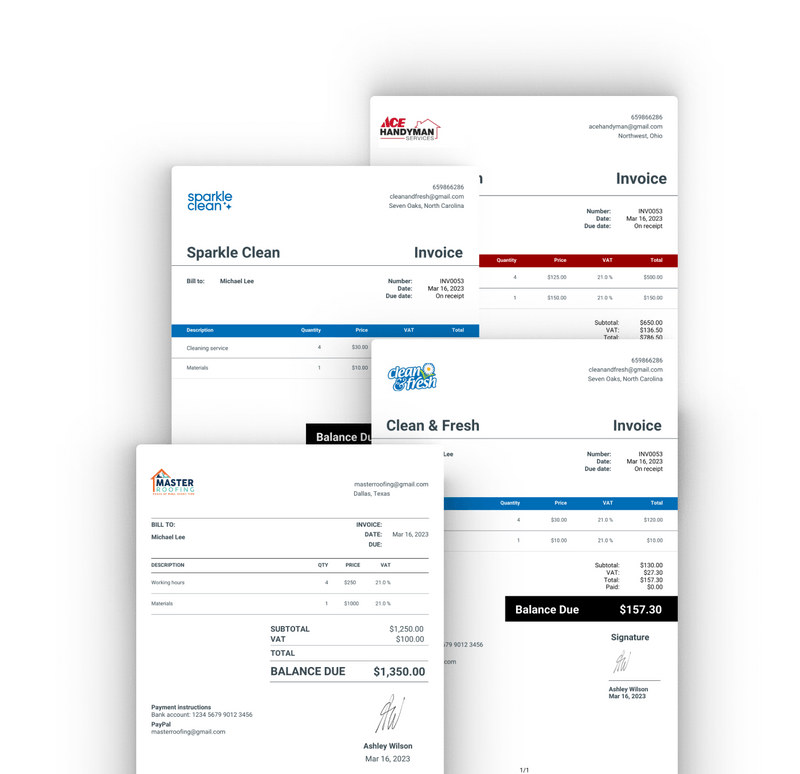
Send Professional Invoices
Learning how to create professional-looking invoices is crucial for your business and getting paid on time.
It also reflects the professionalism of your business or brand towards your customers, so it has to look clean, elegant, and professional, encouraging them to trust your business and pay invoices faster.
In this article, you will find the definition of Invoice, useful tips to ensure professional-looking invoices, and a few templates you can use to create your own.
What is an Invoice?
An invoice is an official document that outlines the amount of money owed to a business or individual, in exchange for goods or services rendered.
It acts as a payment request, detailing the quantity of products or services provided, the total cost, the amount due to the service provider, and the available payment methods.
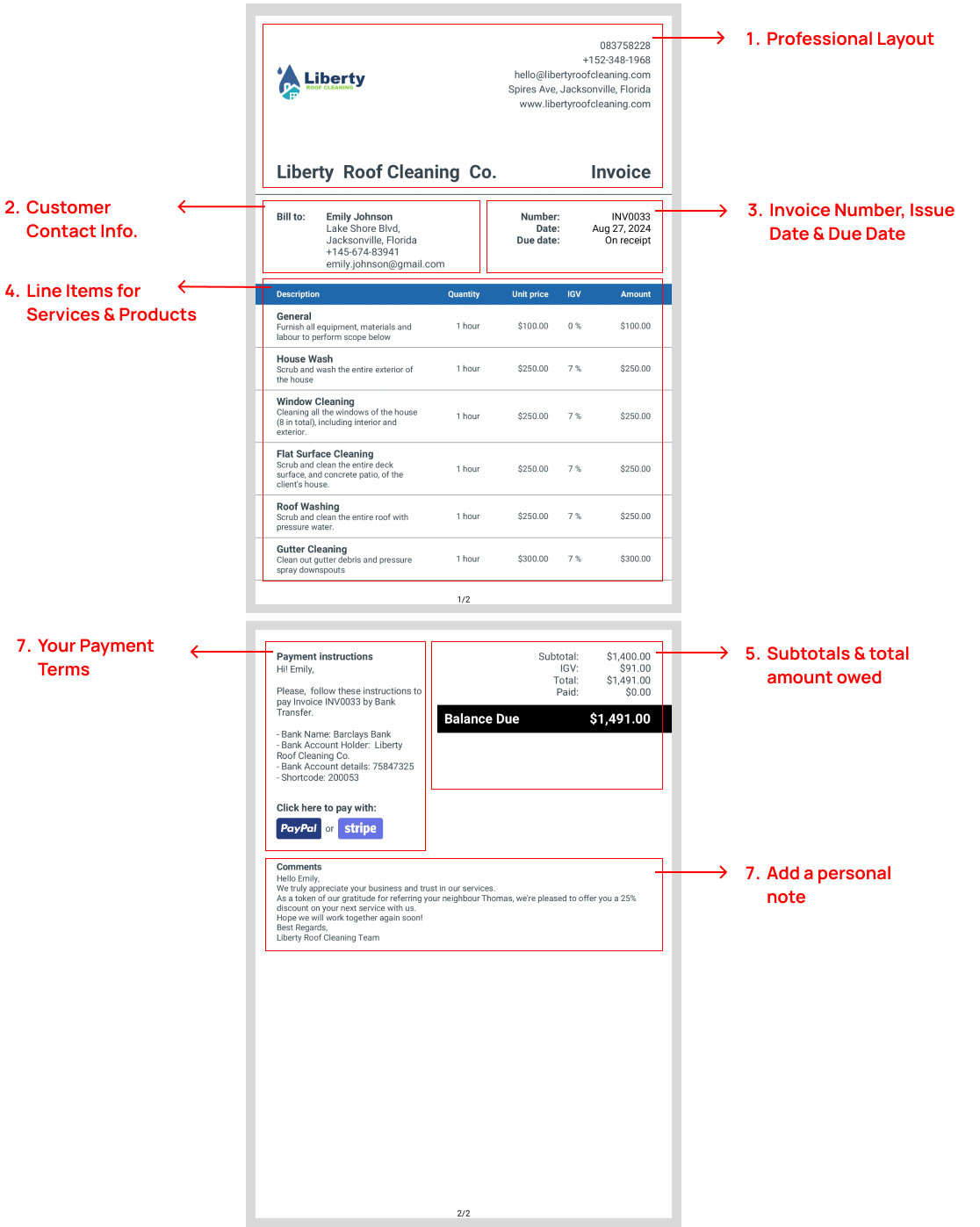
This description is not enough? Read our article “What is an Invoice” for a more accurate description.
There are many ways of creating invoices for your customers. You can craft them by hand, or design a Template using Word, Excel, PDF, Canva, Illustrator, or any kind of digital tool.
However, most of these methods require years of experience and expertise in the industry, and using these kinds of software.
Invoice Fly helps you automate your invoicing process, with Templates, Calculators, and our Invoice Generator tool, which automates this process and helps you send invoices fast.
Try our Invoice Generator tool!
Send professional-looking invoices to your customers and get paid faster with our Invoice Generator tool. Try it now!
Tip for Pros: With our Invoice Generator tool, you can fully customize your invoices, and form your company logo, layout, corporate colors, and text boxes. Give it a try!
RELATED ARTICLE: What is an Invoice? Everything You Need To Know
1. Craft Your Invoice with a Professional-looking Layout
To create the perfect invoice template for your business, you can start by crafting a professional-looking header layout.
It should include your official logo and brand name, with corporate colors, usually aligned on the top-left side of the invoice.
The more professional you look, the more likely you will be to receive fast payments from your clients, as they will feel more secure that your business is trustworthy and reliable.
RELATED ARTICLE: What is a Proforma Invoice? Meaning, Purpose and Examples
2. Company Details & Client Contact Information
Add your Company details: your company name, address, email address, and phone number, at the top of the invoice.
This information is helpful to your clients and helps them reach out to you in case they need aid getting in touch with you, or refer your business to their friends and family, due to the quality of your services.
The following step consists on adding your client’s contact details: the client’s name, the company name (in case it’s a business), phone number, billing address, email address, and service address in case it’s in a different place.
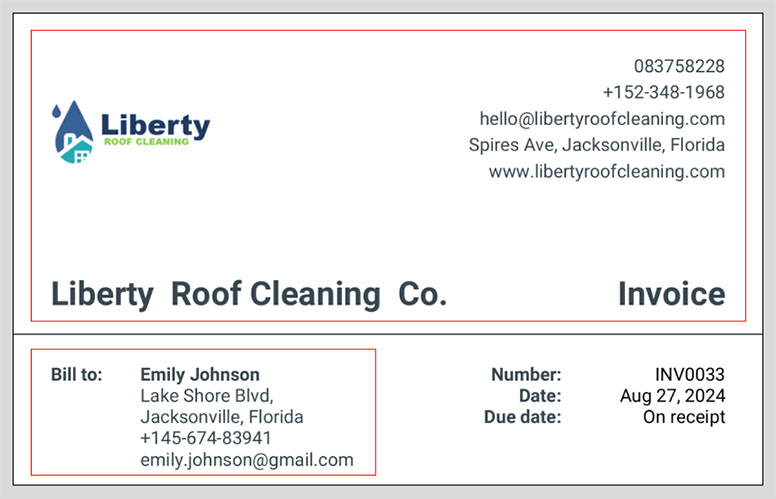

3. Add a Unique Invoice Number, plus the Invoice Creation Date & Due Date
It is essential to emphasize these details for both your client and your business. The invoice number is crucial for organizing and tracking invoices in chronological order.
The creation date indicates when the invoice was issued, helping you and your client keep track of the timeline.
The invoice due date is vital for setting clear expectations, ensuring there are no misunderstandings and avoiding any payment delays.

Additionally, the invoice number and invoice date are essential to meet legal requirements. Proper organization of this information is crucial for tax reporting and managing recurring invoices with the same clients.
Furthermore, if you need to follow up on an unpaid or overdue invoice, referencing the invoice number will help ensure clear communication with your customer, making it easier for both parties to confirm the services provided.
With Invoice Fly, your company and customer details, as well as the invoice number and date, are automatically generated each time. You’ll never have to worry about forgetting or entering the wrong information on your customer invoices.
RELATED ARTICLE: Invoice vs. Bill: What Is The Difference?
4. Write a Description for Each of the Services Provided in the Job
When you’re describing the items included in your invoice, you have to write down the main product or service sold, and then add the detailed tasks, products, and materials used to complete the job.
Remember to include a detailed description of each item used. Be sure to account for the hours dedicated to each service, the unit price, the specific taxes you need to charge, and the total amount for that service.
When naming your line items, be specific about what your client is paying for. Instead of simply listing “Roof Washing,” specify the service by writing “Scrub and clean the entire roof with pressure water”.
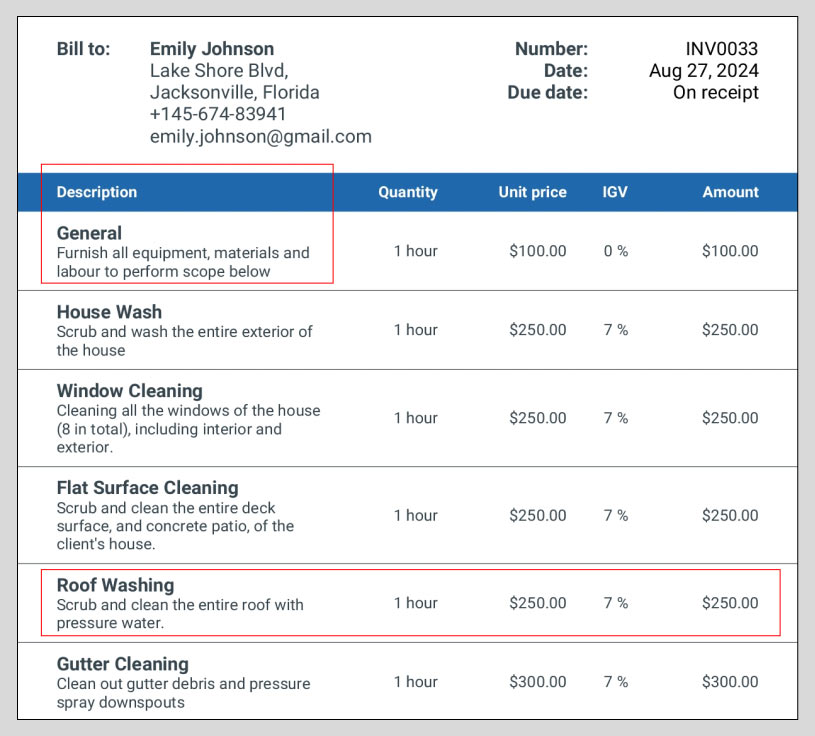
You may also include a list of the products, brands, and materials used for that specific job.
This important information will help your customers understand better the services you executed for the job, and the amount of time invested + materials used.
Customers are more likely to pay your invoices if they understand what are they paying for. Writing an invoice with clear, descriptive line items can encourage quicker payment and reduce questions that might delay the billing process.
RELATED ARTICLE: What Is A Ledger Balance? Definition, Formula and Examples
5. Calculate the Total Amount Due
Sum up the total of each service and item line. Determine the subtotal price and place it almost at the right bottom part of the invoice. Don’t worry about calculating the final amount, Invoice Fly will do that part for you automatically.
The following step involves including any kind of discount you want to offer to your client and also add the taxes for this specific service, in case you need to add it.
The final amount due has to stand out (with a dark background, for example) to avoid any misunderstandings about what’s the due payment of the invoice.
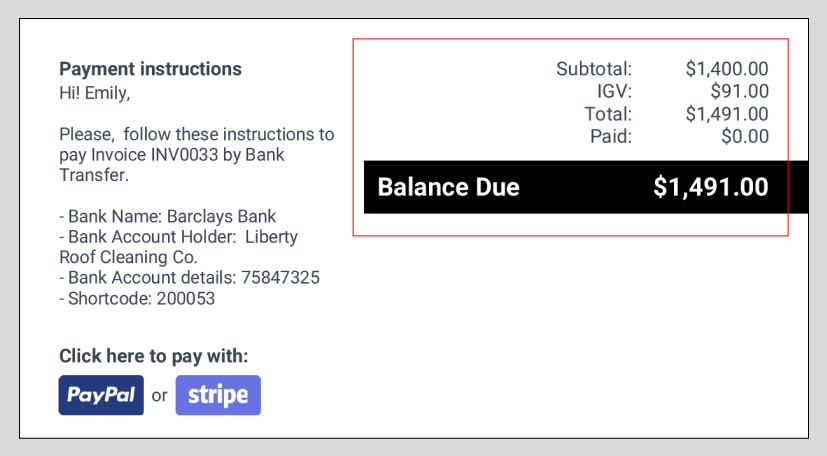
6. Add Your Payment Methods & Terms
The payment process is quite important if you want to have a good customer experience. Making this step easy for your clients will avoid any kind of delay in paying you for your services.
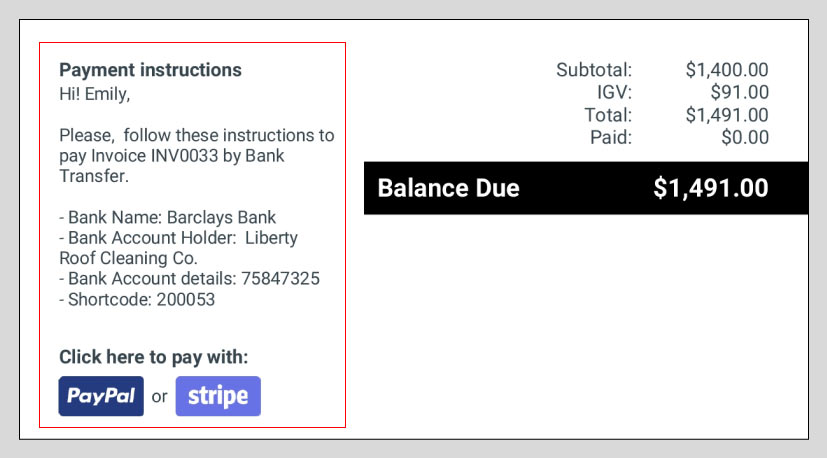
This section is quite important if you want to have a good customer experience. Making this step easy for your clients will avoid any kind of delay when you receive payments for your services.
The payment section of your invoice should include:
- The total balance due, including any kind of discount or sales taxes
- Bank account and payment details for a bank transfer
- Other online payment methods like Stripe or PayPal
- Any additional notes or instructions

7. Thank Your Customer for Choosing You
This is the last part of the invoice and it’s probably the last thing the client will read before paying.
Express gratitude for its continued loyalty and remind him you look forward to doing new business in the future.
You can also add any extra information about upcoming promotions, or referral programs, or request them to leave a positive review about your business.
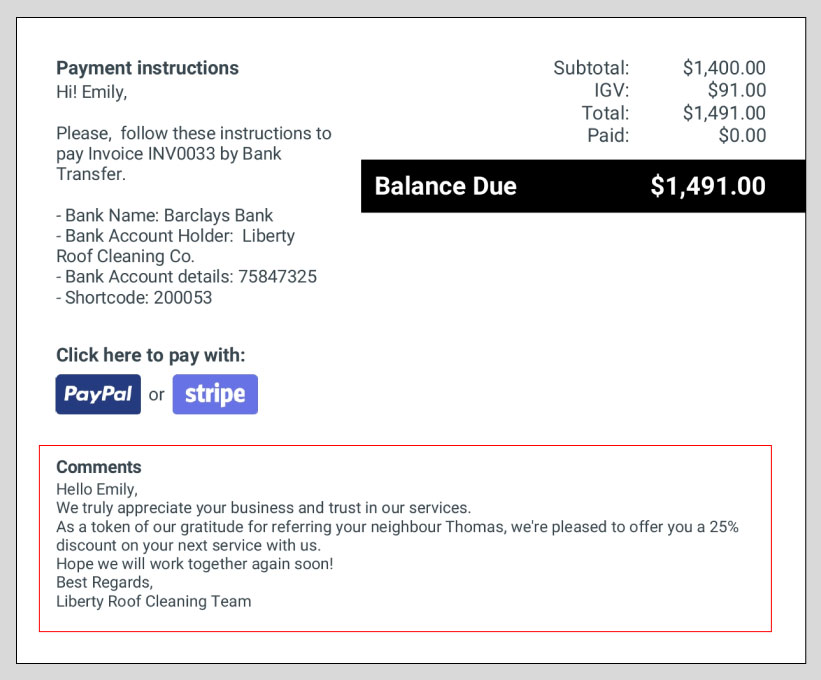
8. Send Your Invoice through Different Channels
Now that your Invoice is complete and ready to be sent to your customers, you need to choose what’s the best communication channel.
The channel should be a commonly used one, making it easy to them to receive it, open it, and pay.
Invoice Fly offers different communication channels to send invoices. You can do it via Email, you can also create a link to share it via WhatsApp, Telegram, or any preferred communication tool.
And you can also download a PDF in case it’s more convenient for both parties.
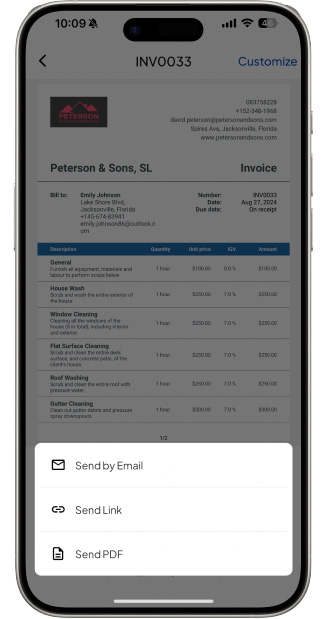
How Does an Invoice Should Look Like?
To sum up, the invoice structure includes a header with your company logo, name and details, the client’s name and details, a list of products and services provided, a description of all costs and the total amount due.
An invoice creation date and payment due date, your payment terms and a thank you message for doing business with you.
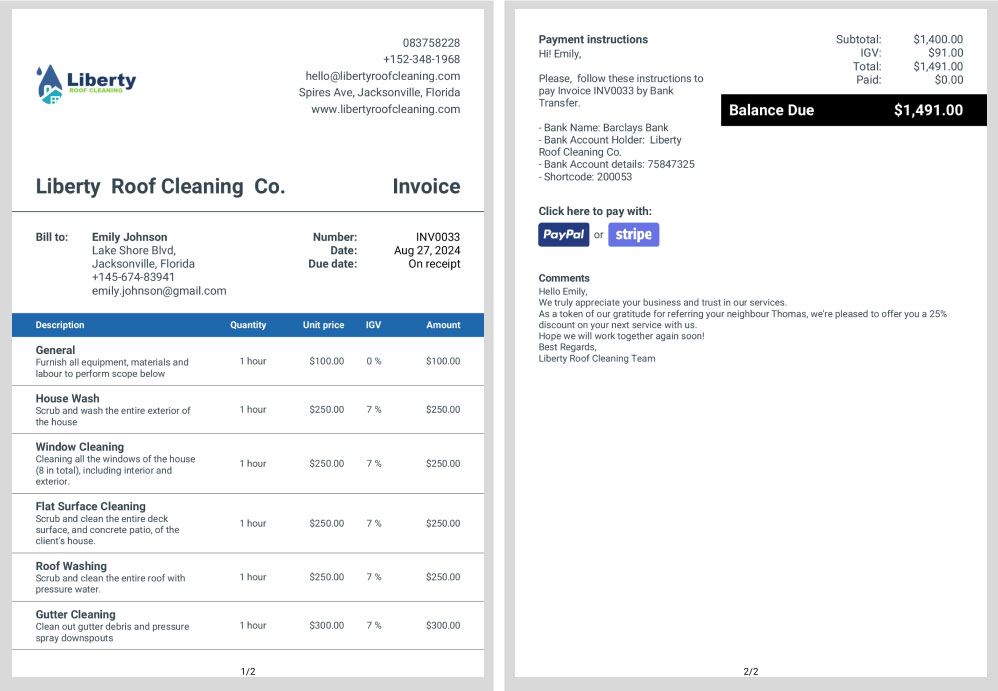
Win more clients by sending them professional-looking estimates
Utilize our free estimate template to produce polished, professional estimates.
Best Practices for Invoicing Professionally in 2024
Now that you have become an expert sending invoices to your customers, let’s go through the best practices for invoicing in 2024, so you’re up to date:
- Send digital invoices online with Invoice Fly.
- Shorten your payment terms. Don’t accept payments longer than 14 days to avoid delays or unpaid invoices.
- Accept deposits and signatures to get paid faster and increase your cash flow.
- Make it super easy for your customers to pay you online or by credit card.
- Use free invoice templates to save office time and look more professional.
Creating and sending invoices to your clients isn’t meant to be a hard and time-consuming task.
In 2024, many processes need to be automated and invoicing is one of them.

